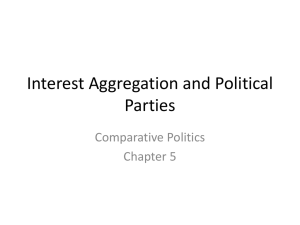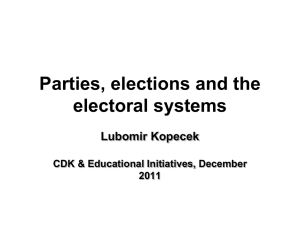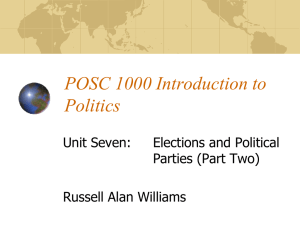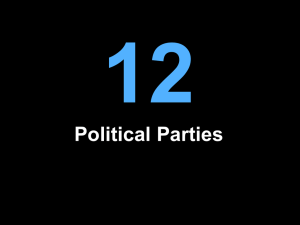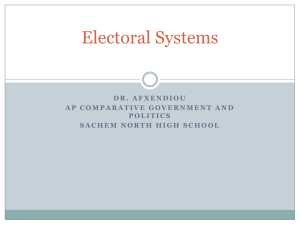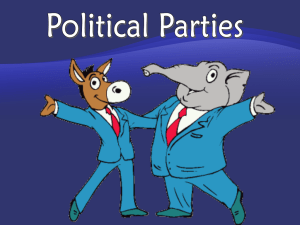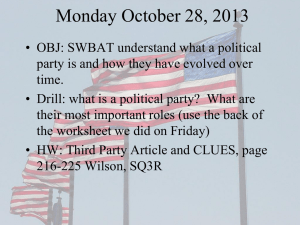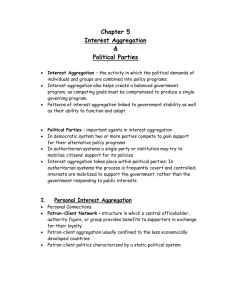Competitive Party Systems - Hackettstown School District
advertisement
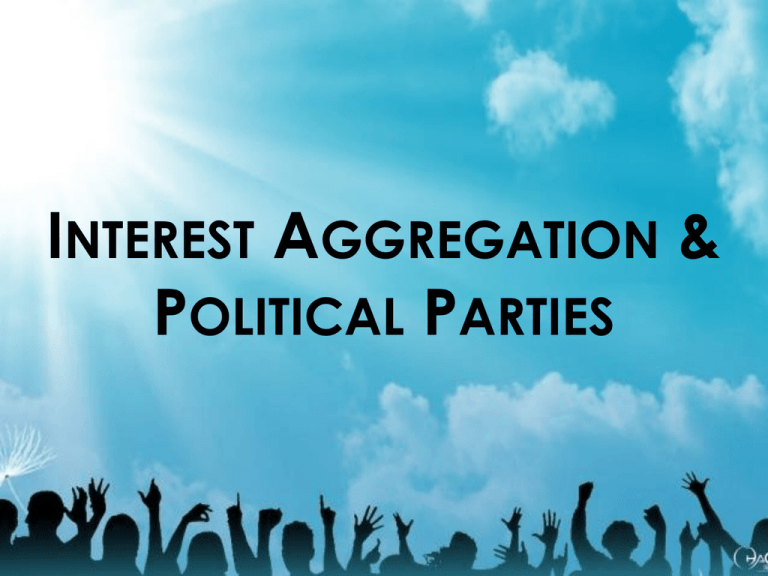
INTEREST AGGREGATION & POLITICAL PARTIES Interest Aggregation • Definition – activity in which the political demands of individuals and groups are combined into policy programs • How interests are aggregated is key in the political process – Determines which interests are heard – What groups are allowed to participate – Effects stability & effectiveness of governments • Occurs in many ways – Influential party leader or dictator may have impact – Large states develop organizations for aggregating interests – Political parties • Authoritarian System – single party • Democratic System – two or more parties Institutional Interest Aggregation • Interest groups with powerful resources cross line between interest articulation & interest aggregation • Institutional groups like bureaucratic agencies & military factions can be interest aggregators – Negotiate with interest groups to identify preferences or mobilize support – Create client support networks to expand organizations Interest Aggregation Party Systems • Parties are often primary structures of interest aggregations • Political Parties are groups or organizations that seek to place candidates in office under their label – Can be one, two, or twenty in a political system! – The number of parties & their relationship are components of a party system • Competitive Party Systems primarily try to build electoral support • Authoritarian Party Systems seek to direct society Competitive Party Systems • Role of competitive parties in interest aggregation depends on each party, the structure of parties, electorates, electoral laws, and policymaking institutions • Aggregation takes place at several stages – Within individual parties – Through electoral competition – After election via bargaining & coalitionbuilding with other parties in the legislature or executive Voting in Competitive Party Systems • Parties live and die by performance in elections • Voting – giving support to political candidates, parties, or policy proposals – is simple & frequently performed political action • Aggregating votes gives citizens ability to make collective decision about leaders or policies • Profound implications – Choice of parties or candidates aggregates political interests – Determine who manages affairs of government and makes policy – Examples: Leftist governments came to power in Europe, expanding size and efforts of government whereas conservative parties generally slow the growth of gov’t • Usually voters can choose whether or not to vote – Some countries require voting Electoral Systems • Definition – rules by which elections are conducted • Determine who can vote, how people vote, and how the votes get counted • Single Member District Plurality (SMDP) Election Rule – the candidate with the most votes in the district wins (not necessarily a majority) – Majority Runoff – voting happens in two stages – first takes a majority, if not, there’s a second round • Proportional Representation (PR) – each district may elect as many as 20 or 30 representatives – Competing parties offer lists of candidates for slots in each district – # of representatives a party wins depends on the overall proportion of the votes it receives Competition Among Parties in Electoral Systems • Formulate appealing policy programs • Nominate attractive candidates • Anticipate offerings of their competitors & preferences of voters • Must offer candidates for office – Primary Elections – in the US, voters select party candidates – Single Member Districts – usually party officials select candidates – Closed-PR Systems – elected representatives drawn from the top of the list – Open-List Systems – voters give preference to individual candidates on the list Patterns of Electoral Voting • Duverger’s Law – relationship between electoral systems and party systems – Plurality single-member district systems create two-party systems in the legislature – Proportional representation systems generate multiparty systems – 2 mechanisms behind it: • Mechanical Effect – way that electoral systems convert votes into seats – Single Member Districts offer no representation unless you finish first in at least one district • Psychological Effect – voters & candidates anticipate the mechanical effect, so voters don’t throw away votes towards candidates they don’t think will win (third parties) – Strategic Voting is giving your vote to a party or candidate who’s not your first choice to avoid an even worse outcome • Downs’ Median Voter Result – parties moderate policies to try to win support of the median voter Authoritarian Party Systems • Attempt to develop policy proposals & mobilize support in a different way from competitive party systems • Aggregation takes place within the party or in interactions with business groups, unions, groups in the bureaucracy or the military • May be sham elections, but citizens have no real opportunity to shape aggregation by choosing between party alternatives Classification of Authoritarian Party Systems • Distinguished according to degree of top-down control within the party and party’s control over other groups in society • Exclusive Governing Party insists on almost total control over political resources – Totalitarianism – Policies legitimized by ideology like communism or national socialism • Inclusive Governing Party recognizes and accepts at least some other groups, but may repress those it sees as serious challenges to its control – Sometimes labeled authoritarian corporatist systems, encouraging formation of interest groups that can bargain, but not supplying political resources to the public – Electoral authoritarianism looks like democratic elections, but political opposition, media, and social organizations cannot criticize or challenge the current regime Recap: Major Differences • Competitive Party Systems and Authoritarian Systems offer interest aggregation • Competitive Party systems aggregate interests in multiple political parties and elections • Authoritarian Systems aggregate interests within the dominant political party • Citizens of competitive party systems have more options in interest articulation and aggregation than in authoritarian systems Activity: Left-Right Scale of Political Parties • Political parties are groups that try to get candidates into office • Members are connected through common political beliefs or ideologies • Step 1 – Predict where these ideologies fall on the leftright spectrum: – – – – – – – Centrism Conservatism Liberalism Reactionism Communism Fascism Social Democracy Political Ideology Spectrum Communism Liberalism Social Democracy LIBERAL Conservatism Centrism Fascism Reactionism CONSERVATIVE STEP 2 • Place Republicans and Democrats along the scale. • The left-right scale is divided up by numbers 1-10 – 1 is Communism – 5 is Centrism – 10 is Fascism Placement of Parties on the LeftRight Scale & Their Voter Support • United States, Labour 2000 • Britain, 2001 • Germany, SPD 2002 PDS Green • France, Socialist 2002 Green Communist • Mexico 2000 Democrats Republicans LiberalDemocrat Conservatives CDU/CSU FDP RPR UDF PRD PAN PRI FN Short Essay • Democrats & Republicans make themselves appear VERY different in elections • But, on the left-right scale, Democrats fall between a 5 and 6, and Republicans fall between a 6 and 7 – not that different! SO, Why do you think Democrats and Republicans in the United States portray themselves as being so radically different when they are not as far apart on the Left-Right Scale as the Labour and Conservative Parties in Great Britain?
